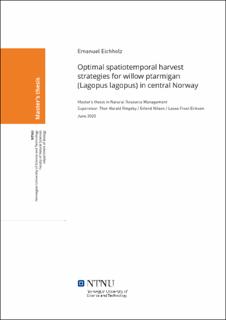| dc.description.abstract | The evolutionary mechanisms and environmental factors that underlie variation in movement behaviors have remained a major challenge in population ecology. This constitutes substantial issues for wildlife managers, as the models that are currently relied upon for making sustainable harvest decisions oftentimes require state-dependent movement as a parameter. Movement is seldomly used in models, an omission which may lead to inaccurate population growth projections and consequently, advise plans of over- or underharvest. As the world faces increased biodiversity loss, unsustainable management of exploited populations can drive populations towards extinctions which may have severe consequences for ecosystems, species, and the human communities that rely on them. This study first investigated the state-specific movements of a population of willow ptarmigan (Lagopus lagopus) in central Norway were investigated. It was found that females moved farther distances than males in terms of seasonal movements between summer and winter season ranges. However, during spring migration no difference was found between adults and juveniles. Sex did not explain variation in breeding dispersal and both male and female adults were found to disperse short distances. Conspecific attraction in juvenile breeding site selection was also investigated, but no evidence for this behavior was found. Nevertheless, further investigation might find conspecific attraction at a finer scale. Second, a harvest model incorporating state-dependent movement patterns was constructed to explore movements effect on population growth rate (lambda, λ) estimates. Movement had a substantial effect on population growth rate, with a gradating dependency on local management area size, neighboring harvest rates, and temporal harvest strategy. In general, the larger the local management area, the less negative impact on population growth rate was seen as a consequence of neighboring regime. When local harvest rates were equal to the neighboring rate, local management area size had no effect on population growth rate. In this scenario projected growth reflected the estimations of a non-spatial population model. This study shows that when designing management plans based on growth rates projected from harvest models, movement patterns and neighboring regimes are essential factors that should be taken into account. Accordingly, strategies must be planned on a regional level to ensure persistent, sustainable local population dynamics. | |
